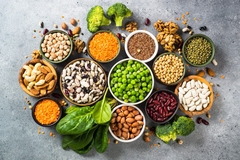UK Food Standards Agency Revises Advice on Certain Artificial Food Colours
The research, carried out by Southampton University, suggests that eating or drinking certain mixes of artificial food colours together with the preservative sodium benzoate could be linked to a negative effect on children’s behaviour.

06/09/07 Parents of children showing signs of hyperactivity are being advised that cutting out certain artificial food colours from their diets might have some beneficial effects on their behaviour. The move follows publication of new research commissioned by the Food Standards Agency.
The research, carried out by Southampton University, suggests that eating or drinking certain mixes of artificial food colours together with the preservative sodium benzoate could be linked to a negative effect on children’s behaviour.
The revised FSA advice follows evaluation of the research by the independent Committee on Toxicity (COT).
The FSA has held an initial meeting with the UK food industry to discuss the research findings and its implications. Representatives from manufacturing and retail organisations told the Agency there was already a trend within industry towards finding alternatives to the colours used in the study. Some technical challenges in developing these alternatives were also highlighted.
Dr Andrew Wadge, the FSA’s Chief Scientist, said: ‘This study is a helpful additional contribution to our knowledge of the possible effects of artificial food colours on children’s behaviour.
‘After considering the COT’s opinion on the research findings we have revised our advice to consumers: if a child shows signs of hyperactivity or Attention Deficit Hyperactivity Disorder (ADHD) then eliminating the colours used in the Southampton study from their diet might have some beneficial effects.
‘If parents are concerned about any additives they should remember that, by law, food additives must be listed on the label so they can make the choice to avoid the product if they want to.’
‘However, we need to remember that there are many factors associated with hyperactive behaviour in children. These are thought to include genetic factors, being born prematurely, or environment and upbringing.
‘The Agency has shared these research findings with the European Food Safety Authority (EFSA), which is currently conducting a review of the safety of all food colours that are approved for use in the European Union, at the request of the European Commission. This review is being undertaken because of the amount of time that has elapsed since these colours were first evaluated.
‘If parents are concerned about any additives they should remember that, by law, food additives must be listed on the label so they can make the choice to avoid the product if they want to.’
The research was commissioned by the Agency to examine the possible effect of the combination of artificial food colours and the preservative sodium benzoate most likely to be found in foods popular with children such as soft drinks, confectionery, and ice cream. A group of three year old children and a group aged eight to nine years old were included in the study.
Professor Ieuan Hughes, Chair of the COT, said: ‘There are constraints when conducting any research involving children. Whilst this research does not prove that the colours used in the study actually cause increased hyperactivity in children, it provides supporting evidence for a link. It is important to stress that the currently available evidence does not identify whether this association would be restricted to certain food additives or combinations of them.’
Professor Jim Stevenson from Southampton University, and author of the report, said: ‘This has been a major study investigating an important area of research. The results suggest that consumption of certain mixtures of artificial food colours and sodium benzoate preservative are associated with increases in hyperactive behaviour in children.
‘However, parents should not think that simply taking these additives out of food will prevent hyperactive disorders. We know that many other influences are at work but this at least is one a child can avoid.’
This was the mix used in the research:
• Sunset yellow (E110)
• Quinoline yellow (E104)
• Carmoisine (E122)
• Allura red (E129)
• Sodium benzoate (E211)
Another mix, which replicated the food colours and preservatives used in a previous study, was also used in the study.
Sodium benzoate was included in both mixes, but the effects observed were not consistent. The Agency therefore considers that, if real, the observed increases in hyperactive behaviour were more likely to be linked to one or more of the specific colours tested.













